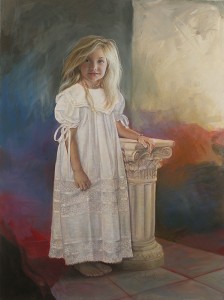The Pros and Cons of Varnishing
In the history of painting, oil portrait varnishing was prevalent in earlier times. However, because the older type varnishes tended to yellow or darken and crack over the ages it gradually became unpopular. With modern technology we are told this has been handled, thus making it desirable again. On the other hand, indoor atmospheres are much cleaner than they were in yesteryear, so varnishing is not needed (or applied) as much as it used to be.
The idea behind varnishing is to protect the painting from any possible environmental dirt, dust and moisture. Many years down the line, if your painting does need cleaning, you can take it to a conservator who would remove the varnish taking the dirt with it. The painting would remain unharmed. Then a new coat of varnish would be applied. If there is no varnish there, the dirt can embed itself into the painting making it difficult to clean.
What I Like About Oil Portrait Varnishing
Because different paints (each with its own chemical and mineral composition), oils, lacquers & thinners are used, paintings can dry unevenly. In some lights you can see dull and shiny patches. To some people this natural raw quality of paintings is desirable. Varnishing evens out a number of these differences by adding a glossy coating to the surface. It also brings out subtle color tones. However, if you would not like a glossy look to your painting, you should not get it varnished—even a matt varnish is moderately glossy.
Note: I put layers of colorless painting medium (medium is used to get a smooth flow with the oil paints while painting) on my portraits as I work because it helps me to see the painting better. When I finish I lay at least one more coat of medium down. Although this coating cannot be removed as varnish can, it does seem to add a little sheen and smooth out the shines of the different colors a bit.
When to Varnish
Oil portrait varnishing should be done after the oil portrait is fully dried. This takes from about 6 months to a year (longer for very thick paint).
How to Get Your Portrait by Jessica Rockwell Varnished
Call us and drop it off. You can pick it up in a couple of days or when it’s convenient for you. We will lightly dust, vacuum (if needed) & varnish the custom oil painting at a minimal charge to you.
[In the unlikely event your painting needs cleaning (from environmental moisture or pollutants such as smoke from a fire place or candles, mould growth from improper temperature, or humidity or insects) it will need to be cleaned first by a professional conservator before any varnishing is done.]
If you prefer for us to do the oil portrait varnishing at your home, there will be a larger fee, somewhat graduated depending on how far away from my studio you are.
If you live out of my area entirely, we suggest that you call a local art store or gallery to find someone who would do it for you. Just say that you need varnish to be put onto an oil painting.
If you would like to have your oil portrait varnishing by us, call us at 727-442-5553 to make arrangements.
Other posts on portrait advices:
• Painted Portrait Versus the Camera
• Old Masters Painting Technique
• Is There a Best Age to Portrait Children?
If you don’t have an oil portrait at all, let me do one for you. Then we can talk about varnishing it!


















